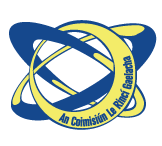History of An Coimisiún le Rincí Gaelacha and Oireachtas Rince ns Cruinne
An Coimisiún le Rincí Gaelacha was established by Conradh na Gaeilge – The Gaelic League – in the late nineteen-twenties as a commission for the purpose of examining the organisation of Irish dancing as it existed at that time and to make recommendations as to how it might be better organised in the future.
The body first met in 1927 as a Commission of Enquiry and in 1930 actually met as an authority with the mandate to implement its own recommendations. Having produced a report after almost two years of deliberations Conradh na Gaeilge appointed that same body of people as an authority with a mandate to set about implementing it's recommendations. Tomás ó Faircheallaigh, who was President of An Coimisiún for some 25 years up to his death in 2004, was the last surviving member of that original commission. In the today’s world of Irish Dancing, it is hard to imagine what it must have been like in the nineteen-thirties. It was An Coimisiún which first established a standard for teachers, and later for adjudicators, of Irish dancing, published a handbook of Céilí dances, and established Oireachtas an Rince, as it was then known, as a separate event. The All Ireland Irish Dancing Championships continue to occupy a special place in the hearts of all those involved in the promotion of our Irish Step dancing, Ceili and Figure Dancing. So many of the things we take for granted, like the international dimension of Irish Dancing, with nine Regional Councils overseeing a vibrant Irish dancing scene in Ireland and Britain and organisations such as the I.D.T.A.N.A. in North America, R.T.M.E. in Mainland Europe, A.I.D.A. in Australia and T.I.D.A.N.Z. in New Zealand carrying on the work of promoting Irish Dancing, could not have happened without the forethought and dedication of those early pioneering members of An Coimisiun le Rinci Gaelacha.
The influence of An Coimisiún continues to spread throughout all five continents, and we now have active teachers of Irish Dancing not only in countries where the traditional Irish diaspora settled, Great Britain, North America, and Australasia, but also throughout continental Europe, in South Africa and as far away as South America.
There can be no doubt that the establishment of Oireachtas Rince na Cruinne, the World Irish Dancing Championships, in 1970 was the most important development in Irish Dancing of the eighty-five years since the founding of An Coimisiún.
From humble beginnings in the tiny theatre of Coláiste Mhuire in Parnell Square in Dublin in 1970, it has grown into an international event of immense proportions with a standing undreamt of back in the thirties. One has only to look to the huge media interest in Oireachtas Rince na Cruinne to see the influence it has had in placing our magnificent Irish Dancing tradition on the world stage. There can be no doubt but that, were it not for the innovative and courageous decision of the members of An Coimisiun in the late nineteen sixties, when the momentous decision to create a World Irish Dancing Championship event, and to stage qualifying events throughout the then catchment area of An Coimisiun, we might never have seen the enormous expansion in interest in Irish Dancing around the World. The explosion in interest in Irish Dancing which took place following the Eurovision Song Contest of 1994, which gave us the brand Riverdance for the very first time, saw Irish Dancing now being practised by people with little or no connection with Ireland. This momentous event took place just two weeks after Oireachtas Rince na Cruinne had celebrated its 25th annivarsary in the Burlington Hotel in Dublin. The runaway success of the subsequent Riverdance-the-Show followed by the phenomenal success of Michael Flatley’s Lord of the Dance in 1996 placed Irish Dancing in a place it had never been before. By the end of the millennium Irish Dance was in demand all around the globe.
Belfast 2000 saw another first for An Coimisiún, when the flagship event moved outside the Republic of Ireland for the first time. The subsequent publication of a video of the Millennium World Championships marked another milestone for An Coimisiún le Rincí Gaelacha. This move was followed by a move outside the shores of Ireland in 2002, when the event was staged for the first time in Glasgow, Scotland. 2009 saw another first for the World Irish Dancing Championships, when they were held in Philadelphia, PA, in the United Staes of America.
Oireachtas Rince na Cruinne celebrated its 40th anniversary in 2010 with its third visit to Glasgow. The return of the event to Dublin in 2011 after a fifteen year absence was a fitting follow-up to that wonderful Glasgow event, and an occasion for great celebration. Since then An Coimisiun has gone on to stage Oireachtas Rince na Cruinne yet again in Belfast in 2012, not to mention another staging of the event in the United States of America in 2013, this time in Boston MA, 2014 saw the event successfully staged for the first time in London, while Montreal, Canada hosted the Championships in 2015. All roads will lead us back to Glasgow in 2016.
One of the important tasks undertaken by the early pioneers of An Coimisiun was the publication of a handbook of ten Ceili Dances in 1939. In subsequent years two more handbooks were published, and all three were later combined in one volume, the study of which has become a requirement for persons aspiring to become teachers of Irish Dancing. In 2014 An Coimisiun commissioned a complete revamp of this publication, and produced a DVD to illustrate the entire thirty dances. This publication will become the official handbook for all events from September 2015 onward.



